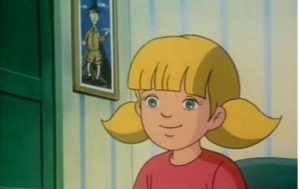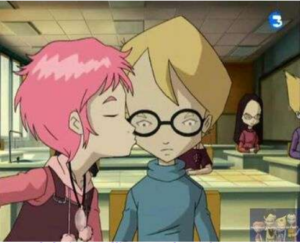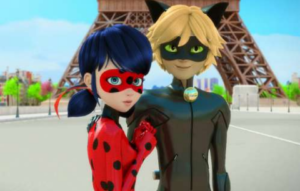FOCUS
#09
From 1950 to today, new genres of cartoons?
By Mélanie Lallet, media sociologist, author of “Libérées, délivrées? Rapports de pouvoir animés” (INA, 2014), lecturer at UCO Nantes, member of the Arènes laboratory and head of research at the Centre Humanités et Sociétés, associated with the Institut de recherche médias, cultures, communication et numérique (Irméccen).
Overview : An analysis of gender representations in French animated programs from the 1950s to the present day does not show a linear progression towards equality, even though some of these programs have made more room for female characters and stories that defy stereotypes.
Cartoon gender dynamics between 1950 and 1990
While there is a complex relationship between television and its influence on society, research shows that French cartoons since the 1950s have not been increasingly egalitarian and representative of changes in society. The first cartoons, produced between 1957 and 1974, not only suffered from a severe shortage of female characters (only 17.9% of the total), but some of them may also have worked in reverse, accentuating gender inequalities in their most recent versions. Over the years, Claude Laydu’s “Bonne nuit les petits” series has moved away from a fair portrayal of Mirabelle and Petit Louis (the ancestors of Nicolas and Pimprenelle) towards a different version of these child characters: in 1962, Petit Louis likes to use the iron, while in the 1995 version, Nicolas refuses to take on household chores, which are taken on by Pimprenelle.
From a strictly quantitative point of view, the following period from 1975 to 1989, still left little room for women, with an average of 19.6% female character cartoons.
Marked by the “Smurfette syndrome”, the productions of this period often made do with a single female character who served as a foil for the white male hero. This was the fate of young Sophie in Inspecteur Gadget (1983-1986, FR3), who helps her uncle by remaining in the shadows and is never rewarded for her work, or of the young Inca Zia, who’s always the victim of some kidnapping that takes her away from the young Spanish hero, Estéban, in Les mystérieuses cités d’or (1982-1983, Antenne 2).

Sophie, ‘Inspector Gadget’, 1982
Since the 1990s, there have been more female characters on screen in more complex roles
Between 1990 and 2004, the proportion of female characters slowly rose to an average of 25.3%. The 1990s also saw the introduction of progressive themes, such as family reunification and sexuality. For example, “Le Bonheur de la vie” (1991, FR3), was contested by certain religious associations for its’ daring sex-education messaging, or in “Les Zinzins de l’espace” (1997-1998 season 1 ; 2005-2006 season 2, France 3), a cartoon that initiated the extraterrestrial character, Candy. They were a LGBT character with a non-binary gender identity, brought to the screen.

Candy, « Les Zinzins de l’espace », 1997
However, the 1990s also saw a return to older imaginary worlds, with the idealisation of male adventurers and no real place for women, such as the series “Once upon a time…” (… “les Amériques”, 1991, Canal+; “les découvreurs”, 1994, Canal +; “les explorateurs”, 1996, Canal+) by Albert Barillé, or the new adventures of comic book heroes such as “Lucky Luke” (1991-1992, FR3) and “Les Aventures de Tintin” (1992, France 3). However, there is a noticeable trend towards a gradual diversification of the female and male identities portrayed in children’s programmes, which becomes more pronounced at the dawn of the 2000s.
In quantitative terms, the proportion of female animated characters rose to 31.3% between 2005 and 2014, a period marked by the arrival of streaming and the kids television channel, Gulli. This figure is still low, but slightly higher in comparison to other forms of media during this time. The decade was marked by the emergence of combative heroines, such as the spies in “Totally Spies!” (2002-2007 seasons 1 to 5; 2013 season 6, TF1), who paved the way for other strong female cartoon characters.
Another example can be seen in the series “Code Lyoko” (2003-2007, France 3), which echoes the struggle for the on-screen representation of marginalized identities, while promoting queer and deconstructivist feminism. The series’ young characters are all slightly atypical, developing on the basis of shared passions and resemblance rather than complementarity. This girl-boy dynamic helps to deconstruct certain stereotypes: Yumi and Ulrick share individualistic qualities while practicing martial arts; Jérémie and Aélita defy social norms and have a passion for computers.

Jérémie et Aélita, « Code Lyoko », 2004
Taking greater account of gender issues
Even today, the norm in action-adventure series’ still sees the only female character dressed all in pink, surrounded by two or three male characters, used to embody femininity that is supposed to satisfy female viewers. There are some notable initiatives, however, such as the series “Les Culottées”, adapted from the work of Pénélope Bagieu, broadcast in 2020. Its ambition was to bring contemporary feminist themes to the screen, while rising to the challenge of addressing children and adults alike. As daring as it is to be progressive, its broadcast on France Télévisions channels were cancelled, after just a few episodes.
The “Chouette, pas chouette” series, developed in 2021 to combat gender stereotypes, have been optioned by several networks (France Télévisions, Disney Channel, Gulli, Piwi+, Nickelodeon, TF1 and Bayard Jeunesse). The 16 episodes were produced with the support of the Centre de liaison de l’enseignement et des médias d’information (CLEMI). The series has also been adapted into an educational booklet to enable school teachers to develop their teaching approaches with activities on themes of gender equality, for k-12 learning.
Ladybug and Chat Noir, « Les aventures de Ladybug et Chat Noir », 2015
For example, the two heroes’ classmates, Rose and Juleka, form a lesbian relationship who have been canonised, throughout the seasons. Although very discreet on screen, fans seize on these representations to produce online fan fiction that places them at the centre of their storylines. The exact same phenomenon can be noted for the couple formed by schoolboys Marc and Nathaniel, even more implicit on screen, but all the more present in fans’ online creations.
The Observatoire des images, created in 2021, is the first associative body to bring together all those interested in the role of images in cinema, television, video games and advertising, particularly on the Internet.
Convinced that images can create representations and lock people into stereotypes, or on the contrary enable emancipation and open up the field of possibilities, the observatory’s partners have come together to reflect and act together, whether their members work in production, distribution, financing, communication, research, institutions, etc.
The coalition’s objectives include
– raise awareness among public authorities, professionals and the general public ;
– develop research into the reception of images and highlight existing work;
– bring together and support professional practices
– to promote projects and teams working to combat stereotypes.
Join us : observatoiredesimages.org


